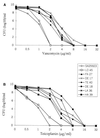Outbreak of methicillin-resistant Staphylococcus aureus with reduced susceptibility to glycopeptides in a Parisian hospital
- PMID: 10921964
- PMCID: PMC87166
- DOI: 10.1128/JCM.38.8.2985-2988.2000
Outbreak of methicillin-resistant Staphylococcus aureus with reduced susceptibility to glycopeptides in a Parisian hospital
Abstract
Epidemiological relationships were investigated between 40 methicillin-resistant Staphylococcus aureus (MRSA) strains with decreased glycopeptide susceptibility isolated from November 1998 to March 1999 from 39 patients (17 infected and 22 colonized patients) in nine wards of the Broussais Hospital, Paris, France. Reduced glycopeptide susceptibility was readily detected on brain heart infusion (BHI) agar containing 6 microg of teicoplanin per ml and on gradient plates, but not by the standard disk diffusion method. The MICs of vancomycin and teicoplanin, determined on BHI agar, were 4 and 8 to 32 microg/ml, respectively (standard antibiotic dilution), and 4 to 8 and 8 to 32 microg/ml, respectively (E-test). All strains were resistant to macrolides, aminoglycosides, tetracycline, rifampin, sulfonamides, and pefloxacin, showed reduced susceptibility to fusidic acid and fosfomycin, and were susceptible to trimethoprim and chloramphenicol. Pulsed-field gel electrophoresis and lysotyping revealed that a multidrug-resistant MRSA clone with decreased susceptibility to glycopeptides has been discretely endemic since at least 1996 in our institution, where it was responsible for an outbreak in November and December 1998.
Figures


References
-
- Ariza J, Pujol M, Cabo J, Pena C, Fernandez N, Linares J, Ayats J, Gudiol F. Vancomycin in surgical infections due to methicillin-resistant Staphylococcus aureus with heterogeneous resistance to vancomycin. Lancet. 1999;353:1587–1588. - PubMed
-
- Brunet F, Vedel G, Dreyfus F, Vaxelaire J F, Giraud T, Schlemmer B, Monsallier J F. Failure of teicoplanin therapy in two neutropenic patients with staphylococcal septicemia who recovered after administration of vancomycin. Eur J Clin Microb Infect Dis. 1990;9:145–147. - PubMed
-
- Centers for Disease Control. Interim guidelines for prevention and control of staphylococcal infection associated with reduced susceptibility to vancomycin. Morb Mortal Wkly Rep. 1997;46:626–628. , 635. - PubMed
-
- Chesneau O, Morvan A, El Sohl N. Retrospective screening for heterogeneous vancomycin resistance in diverse Staphylococcus aureus clones disseminated in French hospitals. J Antimicrob Chemother. 2000;45:887–890. - PubMed
-
- Comité de l'Antibiogramme de la Société Française de Microbiologie. Communiqué. Pathol Biol. 1998;46:1–16.
Publication types
MeSH terms
Substances
LinkOut - more resources
Full Text Sources
Medical

